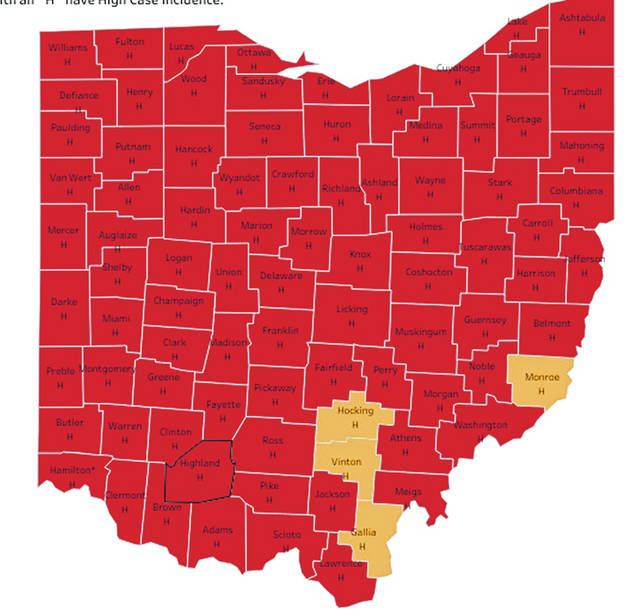
The Buckeye State ended the work week Friday with an additional 9,535 COVID-19 cases, bringing the cumulative total since March of last year to 762,603.
And while another 318 Ohioans were admitted to hospitals and 82 others succumbed to the virus, nearly 8,000 recovered, bringing the total of those that have made a full recovery since last March to over 621,000.
When compared with the 21-day rolling average of the four leading indicators — cases, hospitalizations, deaths and those in intensive care — minimal increases were seen in the last three, with deaths increasing by seven, those hospitalized up by two, and those in the ICU increasing by one.
With the current phase of coronavirus vaccinations underway, Gov. Mike DeWine announced people in Phase 1B of the program will be able to receive vaccinations beginning Tuesday, Jan. 19.
Those 80 years of age and older will be first priority in this next phase, which totals approximately 420,000 Ohioans.
Ohio is expected to receive 100,000 doses during the first week of distribution for Phase 1B.
“With up to 420,000 people 80 years and above, and only 100,000 doses available the first week, it will take several weeks to vaccinate those 80 years of age and older,” DeWine said. “Phase 1B will take a few weeks, and a lot of coordination in distribution.”
Vaccines for that first group of senior citizens will be administered by physicians, local health departments, hospitals, federally qualified health centers, in-home health service providers, and some retail pharmacies.
The Ohio Department of Health reported that it had approximately 1,700 providers registered to distribute vaccines.
DeWine anticipates vaccinations will be available to Ohioans 75 years of age and older beginning Monday, Jan. 25.
The following week, on Monday, Feb. 1, vaccinations will be available for those 65 years of age and older.
“As we include other age ranges, please know that does not mean vaccinations will be complete for the previous age range,” DeWine said.
The week of Jan. 25 will also include vaccinations for Ohioans with severe congenital, developmental, or early-onset medical disorders, and DeWine indicated that additional details about distribution for this group will be forthcoming.
Also during the week of Feb. 1, DeWine said that vaccinations will be available for personnel in Ohio schools.
The Ohio Department of Health will send forms to Ohio superintendents to indicate their plans to return to full in-person and hybrid learning by March 1, as well as indicate the number of staff they believe will choose to take the vaccination.
Superintendents will also be asked if a community partner has been identified to help with the administering of the COVID-19 vaccines to school personnel.
The incidence of highest occurrences statewide changed somewhat from Wednesday, according to ODH’s Friday update, with Highland County’s ranking elevating from number 49 to 42 of the state’s 88 counties.
Highland County had an occurrence rate of 660.3 per 100,000 of population.
Monroe County moved into the number one spot with a rate of 1120.6 per 100,000 of population.
In the local region, Fayette, Brown, Clermont and Warren counties remained in the top 10 at fifth, sixth, seventh and eighth place, respectively.
Clinton and Ross counties both hovered at the border line of the top 20 at the 20th and 21st positions, respectively, while Adams County moved lower in the occurrence rankings to No. 51.
In a related matter, DeWine announced that Ohio Department of Health Director Stephanie McCloud had signed the Sixth Amended Director’s Order, which limits access to the state’s nursing homes and similar facilities, with exceptions.
The revised order clarifies that in-person compassionate care visits are permitted in nursing homes and similar facilities, but doesn’t change required precautions that all visitors must take, including, but not limited to, the wearing of a facial covering and social distancing.
Reach Tim Colliver at 937-402-2571.


